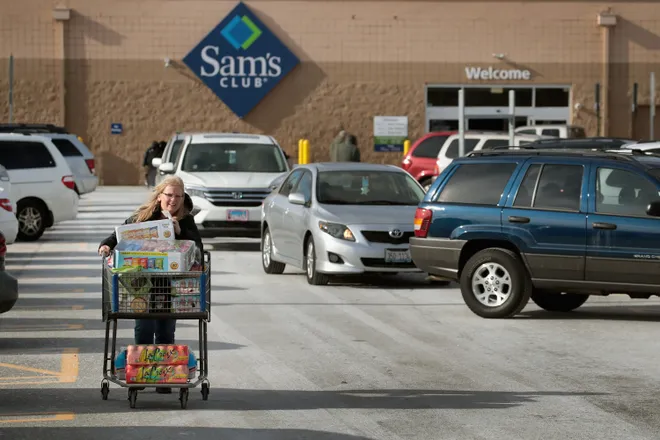The economy grew robust 2.8% in the second quarter. What it means for interest rates.
The economy picked up sharply in the second quarter as a rise in consumer and business spending offset a drop in housing construction and a widening trade gap.
The nation’s gross domestic product, the value of all goods and services produced in the U.S., expanded at a seasonally adjusted annual rate of 2.8% in the April-to-June period, the Commerce Department said Thursday. That’s up from a tepid gain of 1.4% early this year and 2.5% increase for all of 2023.
Forecasters surveyed by Bloomberg had projected a 1.9% increase.

Is the economy doing well right now?
The economy has been surprisingly resilient despite high interest rates and inflation the past two years as a result of strong job and wage gains that have provided consumers the wherewithal to keep spending.
But cracks are beginning to show as high borrowing costs take a bigger toll on households and companies.
Is US consumer spending increasing or decreasing?
In the second quarter, consumer spending increased a solid 2.3% annualized, above the 1.5% pace early this year but just below the more than 3% clip in the second half of 2023. Consumption makes up about 70% of economic activity.
To fuel their purchases, Americans are spending more of their paychecks, saving about 3.8% of their monthly income, well below the average 7% or so they socked away before the pandemic. As a result, they don’t have much cushion. Low and middle-income households have largely depleted their COVID-19-related reserves. Credit card debt is near a record high and delinquencies are historically elevated.
Check it out:What the average household spends on grocery costs per month
More broadly, the economy is forecast to grow less than 2% annualized the second half of the year, according to a survey by Wolters Kluwer Blue Chip Economic Indicators.
"We should receive cooler GDP reports from here on out as consumers tighten their purse strings and businesses become more reticent to invest and hire," says Nationwide economist Oren Klachkin.
When can we expect the Fed to lower interest rates?
Many economists are urging the Federal Reserve to cut its key interest rate − now at a 23-year high of about 5.3% to fight inflation − soon. They argue the risk of acting too late and allowing the U.S. to tip into a recession is starting to outweigh the hazards of moving too soon and reigniting inflation, which has fallen to 3% from 9.1% in 2022. Most forecasters expect the Fed to start lowering its benchmark rate in September.
The sturdy 2.8% rise in output in the second quarter could make the central bank think twice about reducing rates in the near term. And it's likely to "mildly disappoint" investors who hoped the Fed would consider making a surprise rate cut at a meeting next week.
But top forecasters still expect the central bank to make a move in a couple of months.
"The recent loosening of labor market conditions and signs of slower price growth still mean there is a strong case for at a cut" at the Fed's September meeting, economist Stephen Brown of Capital Economics wrote in a note to clients.
How other parts of the economy performed:
Business investment accelerates
Business investment grew 5.2% after rising 4.4% the prior quarter.
Outlays for computers, delivery trucks, factory machines, and other equipment surged 11.6% despite high interest rates that boosted the cost of borrowing. Many companies have purchased labor-saving technology to address labor shortages that continue to plague some industries.
Spending on buildings, oil rigs and other structures fell 3.3%.
Business stockpiling rebounds
Businesses replenished their inventories more briskly after drawing them down the previous quarter, adding nearly a percentage point to growth.
Such stockpiling has been volatile and doesn't typically reflect the economy's underlying health. Companies heavily stocked up in 2021 in response to supply chain snarls and product shortages, leading to big swings the past couple of years.
Government spending increases
Government outlays rose 3.1%, up from 1.8% the previous quarter. State and local purchases have been juiced by a flurry of infrastructure and clean energy projects spurred by sweeping federal legislation.
Economists still expect a pullback in state and local spending amid a gradually slowing economy that has crimped tax revenue and the depletion of the federal government’s pandemic-related aid.
Trade partly offsets GDP gains
Trade was a drag on growth as imports far outpaced exports.
Imports leaped 6.9% as Americans continued to snap up foreign-made products. Exports rose just 2% because of economic weakness overseas and a strong dollar that makes U.S. shipments more expensive for overseas buyers.
That bigger trade gap slowed GDP growth.

Housing dampens growth
Housing construction and renovation dipped 1.4% after three straight quarterly gains.
Home building was picking up because of a severe shortage of existing houses on the market. Many homeowners aren’t selling because they don’t want to be hit with a much higher mortgage rate for their new home.
But recently, single-family housing starts have softened as high mortgage rates have discouraged construction.
Disclaimer: The copyright of this article belongs to the original author. Reposting this article is solely for the purpose of information dissemination and does not constitute any investment advice. If there is any infringement, please contact us immediately. We will make corrections or deletions as necessary. Thank you.







